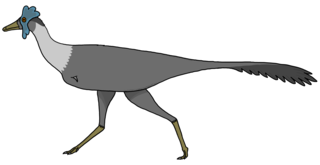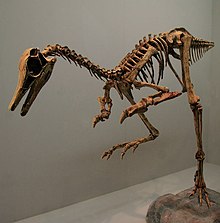
Shuvuuia is a genus of bird-like theropod dinosaur from the late Cretaceous period of Mongolia. It is a member of the family Alvarezsauridae, small coelurosaurian dinosaurs which are characterized by short but powerful forelimbs specialized for digging. The type species is Shuvuuia deserti, or "desert bird". The name Shuvuuia is derived from the Mongolian word shuvuu (шувуу) meaning "bird".

Parvicursor is a genus of tiny maniraptoran dinosaur with long slender legs for fast running.

Alvarezsauridae is a family of small, long-legged dinosaurs. Although originally thought to represent the earliest known flightless birds, they are now thought to be an early diverging branch of maniraptoran theropods. Alvarezsaurids were highly specialized. They had tiny but stout forelimbs, with compact, bird-like hands. Their skeletons suggest that they had massive breast and arm muscles, possibly adapted for digging or tearing. They had long, tube-shaped snouts filled with tiny teeth. They have been interpreted as myrmecophagous, adapted to prey on colonial insects such as termites, with the short arms acting as effective digging instruments to break into nests.

Maniraptora is a clade of coelurosaurian dinosaurs which includes the birds and the non-avian dinosaurs that were more closely related to them than to Ornithomimus velox. It contains the major subgroups Avialae, Dromaeosauridae, Troodontidae, Oviraptorosauria, and Therizinosauria. Ornitholestes and the Alvarezsauroidea are also often included. Together with the next closest sister group, the Ornithomimosauria, Maniraptora comprises the more inclusive clade Maniraptoriformes. Maniraptorans first appear in the fossil record during the Jurassic Period, and survive today as living birds.

Alvarezsaurus is a genus of alvarezsaurid dinosaur from the Late Cretaceous, living in Argentina approximately 86 - 83 million years ago. It was a small dinosaur, measuring 1–1.4 m (3.3–4.6 ft) long and weighing approximately 3 kg (6.6 lb). It was found in the Bajo de la Carpa Formation and was named by paleontologist José Bonaparte in 1991 after the historian Don Gregorio Alvarez. The type species is A. calvoi.

Mononykus is a genus of alvarezsaurid dinosaur that lived during the Late Cretaceous in what is now Asia on the Nemegt Formation, about 70 million years ago.

Patagonykus is a genus of theropod dinosaur from the Upper Cretaceous of Argentina. This alvarezsauroid was discovered in exposures of the Portezuelo Formation (Turonian-Coniacian) of the Rio Neuquén Subgroup in the Neuquén Basin, Neuquen Province of Patagonia, Argentina. The holotype consists of an incomplete but well-preserved skeleton, lacking a skull, but including many vertebrae, the coracoids, a partial forelimb, pelvic girdle, and hindlimbs. Patagonykus has been classed with the Alvarezsauridae, a family which includes such taxa as the Mongolian Mononykus and the Argentinian Alvarezsaurus. In 2010 Gregory S. Paul estimated its length at 1 meter and its weight at 3.5 kg.

Epidexipteryx is a genus of small paravian dinosaurs, known from one fossil specimen in the collection of the Institute of Vertebrate Paleontology and Paleoanthropology in Beijing. Epidexipteryx represents the earliest known example of ornamental feathers in the fossil record.

Ceratonykus is a monospecific genus of alvarezsaurid dinosaur from Mongolia that lived during the Late Cretaceous in what is now the Barun Goyot Formation. The type and only species, Ceratonykus oculatus, is known from a fragmentary skeleton, including an incomplete skull, of an adult individual. It was named and described in 2009 by Vladimir Alifanov and Rinchen Barsbold. Its describers questioned the traditional placement of alvarezsaurs in Theropoda, instead suggesting they were ornithischians, but this has not been accepted since. Ceratonykus has an estimated length of 75 centimetres and weight of 760 grams. It has been considered as a possible junior synonym of Parvicursor.

Haplocheirus is an extinct genus of theropod dinosaur from the Middle Jurassic Shishugou Formation of Xinjiang in China. It is generally considered to be an alvarezsauroid, although some researchers have questioned this assignment. The genus contains a single species, H. sollers, which is known from a mostly complete skeleton including the skull.
Xixianykus is a genus of alvarezsaurid theropod dinosaur from the late Cretaceous period of China.

Linhenykus is an extinct genus of alvarezsaurid theropod dinosaur from the Late Cretaceous of Inner Mongolia, China. It is the most basal known member of the Parvicursorinae. The genus gets its name from Linhe, a city near the site where the fossil was first found and Greek nykus, "claw". The specific name is derived from Greek monos, "single", and daktylos, "finger", a reference to the fact that it is the only known non-avian dinosaur to have had but a single digit.

Bonapartenykus is a monospecific genus of alvarezsauroid dinosaur from Argentina that lived during the Late Cretaceous (Campanian-Maastrichtian) in what is now the upper Allen Formation of the Río Negro Province. The type and only species, Bonapartenykus ultimus, is known from a nearly articulated but partial skeleton that was found in close association to two incomplete eggs and several clusters of eggshells belonging to the oogenus Arriagadoolithus. Bonapartenykus was named in 2012 by Federico L. Agnolin, Jaime E. Powell, Fernando E. Novas and Martin Kundrát. Bonapartenykus has an estimated length of 2.5 m (8.2 ft) and weight of 72 kg (159 lb), making it the largest member of the clade Alvarezsauroidea.

Aorun is a genus of carnivorous theropod dinosaur first discovered in 2006, with its scientific description published in 2013. It is one of the oldest known coelurosaurian dinosaurs and is estimated to have lived ~161.6 million years ago during the Late Jurassic Period. It is the fifth extinct theropod discovered from Wucaiwan, China.

Wulatelong is an extinct genus of basal oviraptorid dinosaur known from the Late Cretaceous Wulansuhai Formation of Bayan Mandahu, Linhe District of Inner Mongolia, northern China. It contains a single species, Wulatelong gobiensis.

Bannykus is an alvarezsaur from the Early Cretaceous of the Bayin-Gobi Formation of Inner Mongolia, China. It includes one species, Bannykus wulatensis. It is large for an alvarezsaur, with an estimated weight of 24 kg based on femoral circumference.

Xiyunykus is an alvarezsaur from the Early Cretaceous of the Tugulu Group of China. It includes one species, Xiyunykus pengi.
Qiupanykus is a genus of alvarezsaurid coelurosaur theropod from the Late Cretaceous Qiupa Formation of southern China.

Shishugounykus is a genus of basal alvarezsaurian dinosaur from the Shishugou Formation from Xinjiang in China. The type and only species is Shishugounykus inexpectus. The specific name refers to the unexpected discovery of another species of alvarezsaur from the Shishugou Formation. Its affinities to alvarezsaurs has subsequently been questioned.





























